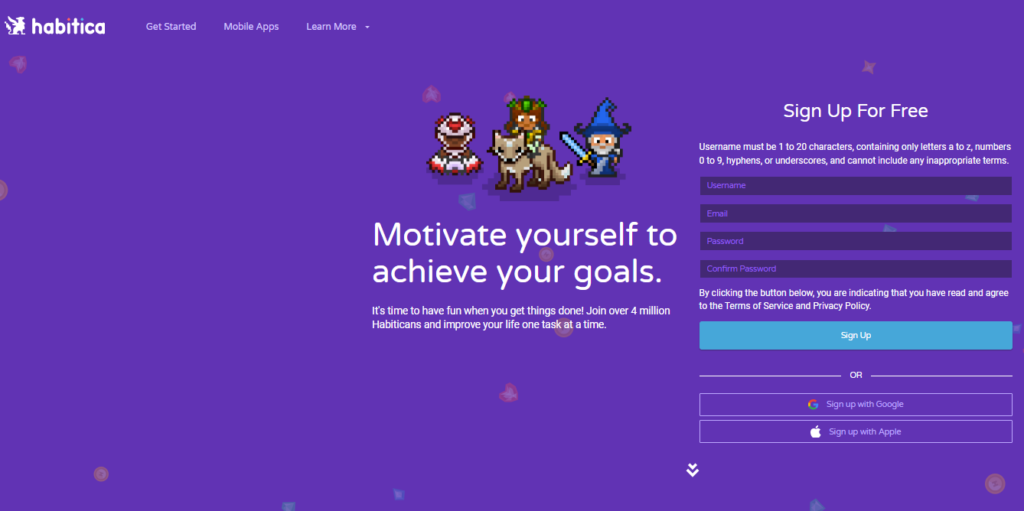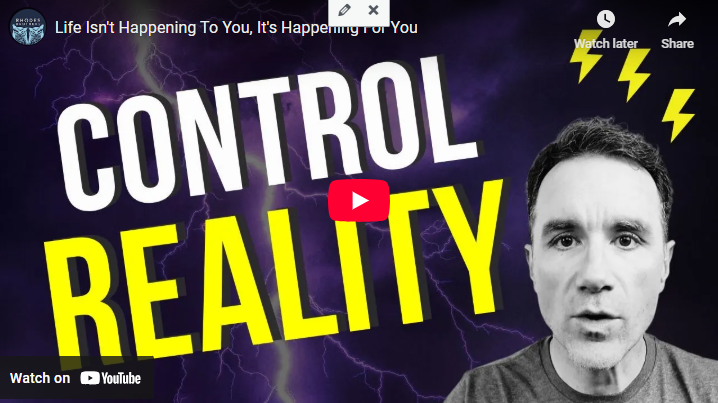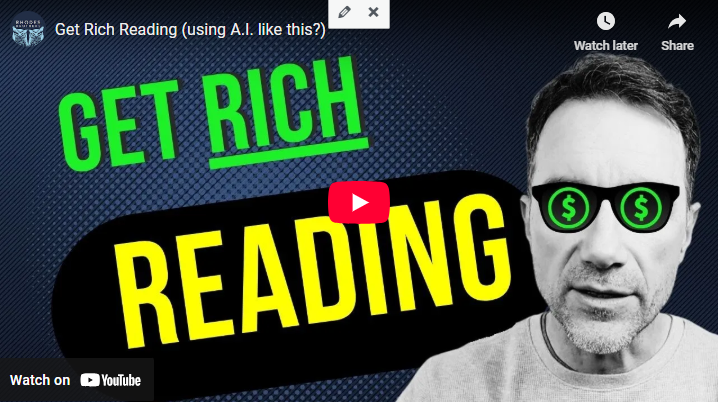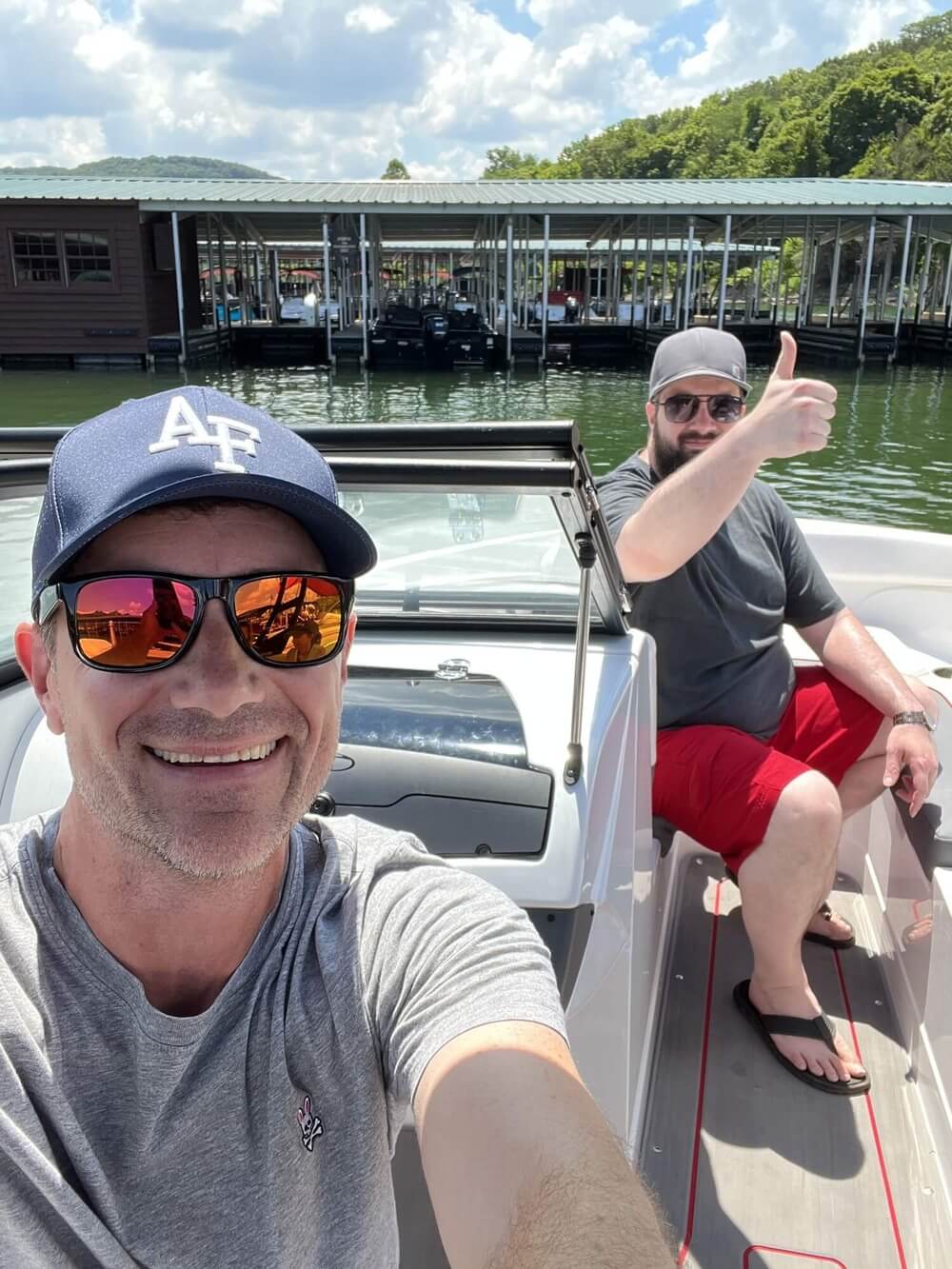For More Free Videos, Subscribe to the Rhodes Brothers YouTube Channel.
Ever feel like you’ve lost your way in the chaos of life? Like the person you were meant to be is buried under the weight of expectations, responsibilities, and endless to-do lists? You’re not alone. The truth is, finding yourself again isn’t some mystical journey reserved for the lucky few—it’s completely attainable for anyone willing to embrace the right approach. And, as John S. Rhodes of the Rhodes Brothers says, “You can recreate and modify your own personal story to take yourself to new heights.” This simple yet profound idea forms the foundation of this guide.

In this post, we’re diving into the transformative power of storytelling—not just as a way to connect with others, but as the ultimate tool to reconnect with yourself. By the end of this article, you’ll have actionable strategies, expert insights, and practical tools to rediscover who you truly are, rewrite your personal narrative, and build a life that feels authentic and fulfilling.
TL;DR
Here’s a quick glimpse of what you’ll uncover in this post:
- The power of storytelling: Learn how stories shape your identity and why rewriting your personal story is the key to rediscovery.
- Step-by-step strategies: Practical tips to reconnect with your inner self, break free from negative narratives, and craft a life you love.
- Tools and techniques: Discover resources like journaling prompts, visualization exercises, and mental frameworks to guide you.
- Common mistakes to avoid: Learn how to steer clear of the traps that keep you stuck in old patterns.
- Actionable advice for everyone: Whether you’re starting fresh or refining your path, these strategies work for all walks of life.
The Secret Power of Stories (and Why They Matter)
Stories are how we make sense of the world—and ourselves. From the bedtime tales we loved as kids to the narratives we create about our successes and failures as adults, storytelling is woven into the fabric of our lives. But here’s the thing: the story you tell about yourself is the most important story of all.
Psychologists call this your “narrative identity.” It’s the internal script that shapes how you see yourself, how you interpret your past, and how you imagine your future. If your self-story is full of negativity—“I’m not good enough,” “I always fail,” “I’m too old to change”—you’ll live a life that matches those beliefs. But if you rewrite your story to focus on resilience, growth, and possibility, you can literally reshape your reality.
As Winston Churchill famously said, “Success is not final, failure is not fatal: It is the courage to continue that counts.” And that courage starts with reframing your story.
Step-by-Step Guide: How to Find Yourself Again Through Storytelling
Feeling lost or disconnected from who you truly are? Don’t worry—you’re not alone. Rediscovering yourself doesn’t require a complete life overhaul; it starts with one powerful tool: storytelling. The stories you tell yourself about your past, present, and future shape your identity and influence your actions. By reflecting on your current narrative and rewriting it with purpose, you can reconnect with your authentic self and create a life that feels meaningful.
Step 1: Reflect on Your Current Story
To rewrite your story, you first need to understand the one you’re currently living. Are you stuck in a narrative of self-doubt? Do you see yourself as a victim of circumstances, or as someone capable of creating change? Reflection is the starting point for transformation.
Tools to Use:

- Journaling: Use prompts like:
- “What is the story I’ve been telling myself about who I am?”
- “What beliefs about myself are holding me back?”
- “What are some moments in my life where I showed strength or resilience?”
- Mind Mapping Apps: Tools like MindMeister can help you visually organize your thoughts and identify recurring themes in your narrative.
Pro Tip: Don’t just focus on the negative. Look for moments of growth, courage, and success, no matter how small.
Step 2: Rewrite Your Personal Narrative
Once you’ve identified the story you no longer want to live, it’s time to rewrite it. This doesn’t mean ignoring challenges or pretending everything is perfect. Instead, it’s about reframing your experiences in a way that empowers you.
How to Do It:
-
- Create a New Script: Write a new version of your story that focuses on your strengths, aspirations, and potential. For example, replace “I’ve always been bad at relationships” with “I’m learning how to build healthier connections.”
- Use Visualization: Imagine yourself living your new story. What does it look like? How does it feel? Apps like Calm and Headspace offer guided visualizations to help you picture your ideal future.
- Positive Affirmations: Write down affirmations that align with your new narrative, such as:
- “I am capable of achieving my dreams.”
- “I am resilient, resourceful, and growing every day.”
Tools to Try:

- Vision Boards: Platforms like Canva make it easy to create digital vision boards filled with images, quotes, and symbols that represent your new story.
- Storytelling Apps: Apps like StoryWorth can help you document and reflect on your personal journey.
Step 3: Reconnect With Your Inner Hero
Every great story has a hero—and that hero is you. But here’s the thing: heroes aren’t perfect. They face challenges, make mistakes, and grow along the way. Embracing your inner hero means recognizing your strengths and treating your setbacks as opportunities for growth.
Actionable Steps:

- List Your Wins: Write down 10 moments in your life when you overcame challenges or achieved something meaningful. These are proof of your resilience and capability.
- Practice Self-Compassion: When you stumble, remind yourself that failure is part of every hero’s journey. Tools like the Shine App offer daily reminders and exercises to nurture self-kindness.
Pro Tip: Heroes don’t go it alone. Surround yourself with people who uplift and support you, whether that’s a mentor, a friend, or an online community.
Step 4: Use Stories to Inspire Action
Your personal story isn’t just about reflection—it’s a tool to take action. By framing your goals as the next chapter in your journey, you create a sense of excitement and purpose.
How to Do It:
- Break Goals Into Chapters: For example, if your goal is to start a new career, Chapter 1 might be updating your resume, while Chapter 2 is networking with industry professionals.
- Celebrate Small Wins: Every step forward is a plot twist worth celebrating. Reward yourself to stay motivated.
Tools to Try:

- Goal-Tracking Apps: Apps like Trello or Notion can help you organize your goals into chapters and track your progress.
- Habit Trackers: Use tools like Habitica to gamify your journey and stay consistent with new habits.
Step 5: Immerse Yourself in Positive Narratives
The stories you consume—from books and movies to the conversations you have—shape your mindset. To find yourself again, surround yourself with narratives that uplift and inspire you.
Suggestions:
- Read Inspiring Memoirs: Dive into stories of people who overcame challenges similar to yours. Some great options include:
- Becoming by Michelle Obama
- The Glass Castle by Jeannette Walls
- Join Supportive Communities: Platforms like Meetup or Facebook groups can connect you with like-minded individuals who share your goals and values.
Actionable Steps to Find Yourself Again Through Storytelling
Rediscovering yourself through storytelling is a profound yet personal journey, and the steps you take will depend on your current stage in life, experiences, and aspirations. Whether you’re starting fresh, navigating a major life transition, or simply seeking deeper fulfillment, there are practical strategies you can use to reconnect with yourself and rewrite your personal narrative.
If you’re a beginner and feel completely disconnected from who you are, start with small, manageable steps. Create a quiet space for reflection where you can explore your thoughts without distractions. Journaling is a powerful tool for this stage—use prompts like, “What are three things I love about myself?” or “What moments in my life made me feel most alive?” to begin uncovering your authentic self. Pair this with tools like mind mapping apps such as MindMeister to visually organize your thoughts and identify recurring themes in your story. Once you’ve reflected on where you are, take a single negative belief—such as, “I’m not good enough”—and reframe it into a positive affirmation like, “I am capable of learning and growing.” This small shift lays the foundation for a new narrative.
For millennials, who often face life transitions like career changes, relationship shifts, or the pressures of balancing personal goals with societal expectations, storytelling can help realign with their core values and passions. Start by mapping out your life story so far. Draw a timeline of your major milestones—both the highs and the lows—and reflect on how these experiences have shaped who you are today. Ask yourself questions like, “What lessons have I learned from these moments?” and “What values have remained constant throughout my journey?” Tools like Canva can help you create a visual representation of your timeline or vision board, making your journey feel tangible. From there, identify what truly lights you up by reflecting on activities that make you lose track of time or topics you’re naturally drawn to. Use frameworks like Ikigai (the Japanese concept of finding purpose) to align your passions, skills, and values. Once you’ve identified an area where you feel disconnected—such as your career or personal life—frame it as the beginning of a new chapter, breaking it into small, actionable steps like taking a class, networking, or creating a side project.
For people nearing retirement, storytelling can help redefine identity during this significant life change. Retirement often brings feelings of lost purpose or uncertainty, but it’s also an opportunity to craft a meaningful new chapter. Begin by reflecting on your legacy. Ask yourself, “What do I want to be remembered for?” and “What values or lessons do I want to pass on to others?” A gratitude journal, such as Penzu, is a great way to celebrate your accomplishments while focusing on what matters most to you. Revisit forgotten passions from earlier in life—perhaps hobbies, dreams, or interests you set aside due to work or family obligations. Consider picking up a new skill through local classes, online platforms like MasterClass, or volunteering in causes that align with your values. Finally, craft a vision for your ideal retirement. Write a story about what this chapter looks like, including how you spend your days and contribute to the world. Turn this vision into actionable goals, such as traveling, mentoring younger professionals, or starting a passion project.
If you’re feeling stuck in a rut—whether due to burnout, a breakup, or other life challenges—storytelling is a powerful way to regain clarity and momentum. Start by accepting your current chapter instead of resisting it. Write a short narrative about where you are right now, framing it as a temporary but meaningful part of your journey. For example, you might write, “This is the chapter where I’m learning resilience,” or “This is the part of my story where I begin to rediscover my strength.” Shifting your perspective from self-pity to empowerment opens the door to change. From there, explore “what if” scenarios to imagine alternative paths your life could take. Ask yourself questions like, “What if I pursued my dream career?” or “What if I prioritized my health and happiness?” Use tools like FutureMe.org to write a letter to your future self, envisioning the life you want to create. Once you’ve imagined these possibilities, take one small, brave step toward your new story, such as joining a local hobby group, signing up for an online course, or decluttering your space to create mental clarity.
For high achievers who may already be successful but feel a disconnect between their accomplishments and their sense of fulfillment, storytelling can help realign their actions with their deeper purpose. Start by reassessing your “why.” Reflect on what initially motivated you to pursue your goals and ask yourself whether that still aligns with who you are today. Use values clarification exercises to identify what matters most to you now, and adjust your story accordingly. For example, if family is a top value but you’re always working late, rewrite your story to prioritize quality time with loved ones. Tools like Habitica can help you build daily routines that reflect these new priorities. Finally, consider sharing your story to inspire others. Whether it’s mentoring younger colleagues, writing about your journey on LinkedIn, or starting a community initiative, using your experiences to uplift others can bring a renewed sense of meaning to your life.
No matter your stage in life, there are universal tools that can support your journey. Journaling apps like Day One or Penzu allow you to reflect on your narrative. Visualization tools like Calm or Headspace help you picture your ideal future. Vision boards, whether physical or digital (using platforms like Canva), bring your goals to life in a tangible way. Goal-tracking tools like Trello or Notion keep you accountable as you work toward your new story. And if you’re unsure where to start with self-reflection, prompts from books like The Artist’s Way by Julia Cameron can guide you.
Ultimately, storytelling is a tool that works for everyone, regardless of age, background, or current circumstances. By reflecting on your past, reframing your present, and imagining your future, you can craft a narrative that is empowering, authentic, and uniquely yours. Whether you’re starting fresh, navigating a transition, or refining your path, your story is yours to write—and the next chapter starts now.
Common Mistakes to Avoid When Finding Yourself Through Storytelling
The process of rediscovering yourself through storytelling is transformative, but it’s not without its challenges. Along the way, it’s easy to fall into traps that keep you stuck in old patterns or hold you back from making real progress. By being aware of these common mistakes, you can avoid the pitfalls and stay focused on crafting a narrative that empowers and inspires you.
Clinging to Old Narratives
One of the biggest roadblocks to rewriting your story is holding onto old narratives that no longer serve you. These narratives often stem from past mistakes, failures, or negative experiences that you’ve internalized as unchangeable truths. For example, you might tell yourself, “I’m just not good at relationships,” or “I’ll never be successful because I’ve failed too many times before.” These limiting beliefs act like anchors, keeping you tethered to a version of yourself that doesn’t reflect your potential.
To overcome this, remind yourself that your story is a work in progress. Your past doesn’t define you—it’s simply one part of a much larger narrative. Instead of clinging to old labels or identities, focus on reframing those experiences as lessons or stepping stones. For instance, instead of saying, “I failed at starting a business,” reframe it as, “I learned valuable lessons that will help me succeed in the future.” Letting go of old narratives requires courage and self-compassion, but it’s essential for growth.
Pro Tip: Use reflective journaling to challenge old beliefs. Write down a negative story you’ve been telling yourself, and then rewrite it with a more empowering perspective. Apps like Day One can help you track these shifts over time.
Perfectionism
Another common mistake is believing that your rewritten story needs to be flawless. Many people get stuck in the idea of crafting the “perfect” narrative, which can lead to paralysis and frustration. They feel pressure to get everything right, to have a clear and polished vision of their future, or to avoid making mistakes along the way. But here’s the truth: perfectionism is the enemy of progress.
Authenticity always beats perfection. Life is messy, and so is the process of rediscovery. Your new story doesn’t need to be a masterpiece—it just needs to be honest and reflective of who you are right now. Embrace imperfection as part of the journey, and remember that your story will evolve as you do. It’s okay to write a rough draft, to make edits, and to revise as you grow.
Pro Tip: Give yourself permission to make mistakes. Use tools like vision boards (physical or digital, such as Canva) to map out your goals and dreams without worrying about getting it “perfect.” Vision boards are fluid, and you can always add or change elements as your story evolves.
Lack of Action
Reflection is an essential part of finding yourself, but it’s only half the equation. Without action, your story won’t change. Many people fall into the trap of overthinking or endlessly analyzing their life without taking concrete steps toward their goals. They might feel inspired by their new narrative but hesitate to act out of fear, uncertainty, or overwhelm.
The key to avoiding this mistake is to take small, consistent steps. You don’t need to overhaul your entire life overnight; instead, focus on actionable goals that align with your rewritten story. For example, if your new narrative is about prioritizing your health, start with something manageable like committing to a 10-minute walk each day or preparing one healthy meal a week. These small wins build momentum and confidence over time.
Pro Tip: Use goal-tracking tools like Trello or Notion to break your story into actionable steps. Create a checklist for each “chapter” of your journey and celebrate every milestone, no matter how small.
Comparison
It’s natural to look at others for inspiration, but comparison can quickly become a trap that derails your progress. When you compare your journey to someone else’s, you risk diminishing your own experiences and achievements. You might think, “They’ve already achieved so much more than I have,” or “Why is it taking me so long to figure things out?” This mindset not only fosters self-doubt but also distracts you from focusing on your unique path.
It’s important to remember that every hero’s story is different. You’re not in a race or competition with anyone else. The challenges you face, the lessons you learn, and the pace at which you grow are entirely your own. Instead of comparing yourself to others, use their stories as inspiration while staying grounded in your own journey.
Pro Tip: Practice gratitude to counteract comparison. Each day, write down three things you’re proud of or grateful for in your own life. This simple exercise helps shift your focus from what others are doing to what’s going well in your own story.
Frequently Asked Questions (FAQs)
How do I start rewriting my personal story?
Begin with reflection. Write down your current story, identify limiting beliefs, and reframe them into empowering narratives.
What if I don’t know who I am anymore?
Start small. Reflect on your values, passions, and strengths. Journaling and talking to trusted friends can help.
Can storytelling really change my life?
Yes! Stories shape how we see the world and ourselves. By changing your narrative, you change your perspective and actions.
What tools can I use to track my progress?
Apps like Notion, Trello, and Evernote are great for organizing goals and tracking milestones.
How do I stay motivated?
Celebrate small wins, surround yourself with supportive people, and revisit your vision board regularly.
What if I fall back into old habits?
It’s normal to slip up. The key is to recognize the pattern, reframe it, and keep moving forward.
How can I use storytelling in my career?
Share your journey authentically in interviews, networking events, or personal branding efforts. Stories make you memorable.
Can this help with relationships?
Absolutely. Understanding your own story helps you communicate better and empathize with others.
Is this approach backed by science?
Yes. Studies in psychology and neuroscience highlight the transformative power of storytelling and reframing techniques.
How long does it take to see results?
It varies, but small changes can lead to noticeable improvements in just a few weeks.
Rewrite Your Story, Rediscover Yourself
Finding yourself again doesn’t mean starting over—it means taking control of your narrative and turning your life into a story worth living. As John S. Rhodes says, “You are the hero of your story. Rewrite it, live it, and be proud of it.”
Start today by taking one small step. Whether it’s journaling, creating a vision board, or simply saying, “Once upon a time, I decided to change,” your new story begins now. And remember: You don’t have to do it alone. Subscribe to the Rhodes Brothers YouTube Channel for more insights, inspiration, and tools to help you succeed.
Resource List
Books
- The Power of Story by Jim Loehr
- Atomic Habits by James Clear
- Man’s Search for Meaning by Viktor Frankl
Podcasts
Tools
- Trello for organizing goals
- Gratitude Journal App for daily reflections
- Calm for mindfulness and visualization practices
Your story is waiting to be written—go make it a masterpiece.





